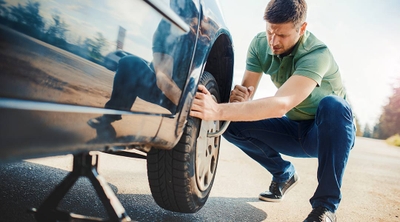What should my tire pressure be?
5 min read
Many passenger car manufacturers typically recommend a normal tire pressure range of 30-35 pounds per square inch (PSI). To determine the correct tire pressure for your vehicle, check your owner's manual. According to Jonathan Ganther, COO and Founder of Brakes To Go, "Recommended tire pressure will vary by your car's make and model, and tire. On the driver's side, there's a tire pressure guide sticker on the inside [of the door] with a picture of a tire with pressure information."
Car manufacturers typically list proper tire pressure in PSI for cold tires. You must check tire pressure when the tires are cold because driving heats the tires and increases the pressure inside, which gives an inaccurate reading. Most modern cars have tire pressure monitoring systems (TPMS) that alert you with a dashboard warning light if your tires are not at the recommended tire pressure level. According to Consumer Reports, your vehicle's TPMS alerts you when your tire pressure is 25 percent lower than the manufacturer's recommended cold tire pressure.
What are the benefits of maintaining proper tire pressure?
- Improved safety: Properly inflated tires are essential for safe driving because they ensure optimal contact with the road, which improves traction, handling, and braking.
- Increased fuel efficiency: Maintaining proper tire pressure ensures your vehicle operates efficiently, which can save on fuel.
- Extends tire life: Proper inflation can help tires wear evenly, prolong their lifespan, and save you money on replacing tires sooner than necessary.
- Reduced risk of tire failure: Proper tire pressure helps prevent flat tires caused by overheating, reduces the risk of punctures, and may minimize blowouts.
- Maintains warranty coverage: Your tire warranty might require regular maintenance, including keeping tires at their proper pressure, to remain valid. If you neglect checking tire pressure, you could void the warranty.
What are the risks of low tire pressure?
Driving with low tire pressure can lead to risks and adverse effects on your vehicle's performance and safety. Some of the risks of driving on underinflated tires:
- Increased tire wear: Low tire pressure increases the tire's contact area with the road, causing it to wear out quickly and unevenly.
- Reduced fuel efficiency: Underinflated tires can increase resistance, causing your engine to work harder, which increases fuel consumption and less fuel efficiency.
- Poor handling and instability: Low tire pressure can negatively affect the vehicle's handling and stability, making it more challenging to steer and control.
- Increased braking distance: Vehicles with underinflated tires may experience increased braking distances, making it more difficult to stop quickly when necessary.
- Increased risk of tire blowouts: Driving on low-pressure tires causes heat to build up within the tire, weakening the structure and increasing the risk of a blowout.
"The recommended tire pressure means you are safe to drive down the road and have a comfortable ride," says Ganther. "The maximum pressure is the max amount the tire can hold without being unsafe." Maximum pressure plays a larger role in SUVs and trucks that haul heavy loads. Your tire's PSI will naturally decrease over time, but too much can point to a problem.
According to Ganther, "Losing about 1 to 2 PSI each month is considered normal." You might have a leak somewhere in the tire if there is more loss than that.
Does temperature affect tire pressure?
Yes, heat and cold can impact tire pressure. Tire pressure goes down when the temperature drops. Tire pressure changes approximately one pound per square inch for every 10 degrees of temperature change up or down, according to Consumer Reports. If you're curious about “What should my tire pressure be in the summer?" or "What should my tire pressure be in the winter?" know that the tire pressure recommended for your vehicle make and model doesn't change according to the temperature outside. You may check your tire pressure when there's been a cold snap to see if your tires need air.
How to check your tire pressure
You can manually check for normal tire pressure using a tire pressure gauge. There are multiple types of tire pressure gauges available. They only cost a few dollars and can be found at gas stations, auto parts stores, grocery stores, or other retailers. Learn how to read tire sizes and numbers to find your recommended tire pressure.
How to properly inflate your tires
To fill your tires at a gas station, Firestone recommends bringing your tire gauge, as the ones on the coin-operated air dispensing machines aren't always accurate. Also, make sure to get a reading when your tires are cold, preferably after they've been sitting overnight.
- Park close enough to the air dispenser machine to reach each of your tires.
- Unscrew and remove the valve stem caps from the tires.
- Check the air pressure in each tire with a tire pressure gauge.
- Press the air compressor hose fitting down on the valve stem and secure it.
- You may have to press a button or flip a switch on the air compressor to get the air flowing after you've paid.
- Add air with the hose to each tire one by one if the pressure is low.
- Stop and ensure that you're not overinflating the tires.
- If you've added too much air, you can release some of it by pressing firmly on the pin with a flat head screwdriver or the back of the air-pressure tool
- Re-check the tire pressure.
- Screw the valve caps back on once all the tires are properly inflated.
How can I avoid a flat tire?
Having the optimal tire pressure for your car may help you avoid a flat tire. But flat tires can also be caused by punctures from nails or ruptures from roadway damage, such as hitting a large rock. A drop in pressure from cold weather and worn tire treads can also cause flat tires. Learn how to fix a flat tire and what to do if you are driving with a nail in your tire.



